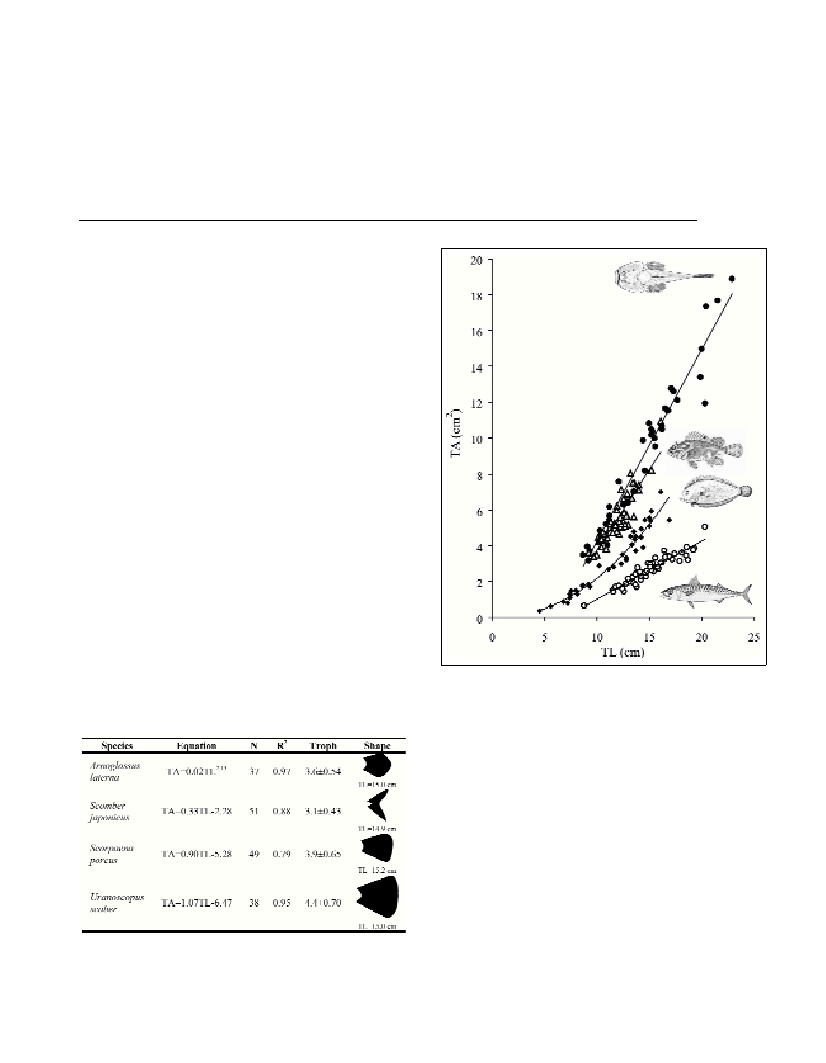PRELIMINARY RESULTS ON RELATIONSHIPS BETWEEN TAIL AREA
AND TOTAL BODY LENGTH FOR FOUR FISH SPECIES
P. K. Karachle* and K. I. Stergiou
Aristotle University of Thessaloniki, School of Biology, Department of Zoology, Laboratory of Ichthyology,
Thessaloniki, Greece - * pkarachl@bio.auth.gr
Abstract
We present tail area-length (TA-TL) relationships for four fish species. TA was linearly related to TL for Uranoscopus scaber, Scomber
japonicusand Scorpaena porcusand was a power function of TL for Arnoglossus laterna, and positively (p<0.05)related with trophic
level.
Keywords: Arnoglossus laterna, Scomber japonicus, Scorpaena porcus, Uranoscopus scaber, tail area-length relationships
Rapp. Comm. int. Mer Médit., 37,2004
376
Introduction
Relationships among various morphometric characteristics of fish
have been the object of extended research, mainly focusing on
relationships between different types of lengths and weight, with an
increasing interest on other types of relationships (e.g., girth: 1; mouth
dimensions: 2). In contrast, relationships involving tail characteristics
(e.g., area, height, aspect ratio), despite their well documented
importance (3; 4) have not been studied extensively.
In this study we present preliminary results on tail area-length
relationships for four fishes, using data obtained within the framework
of a research project on the trophic ecology and feeding habits of
more than 40 fish species.
Materials and methods
Samples of Arnoglossus laterna,Scomber japonicus, Scorpaena
porcus, and Uranoscopus scaberwere collected from commercial
fishing vessels (i.e. purse seiners, trawlers and small-scale gill-
netters), in N-NW Aegean Sea, and preserved in 10% formalin
solution. For all individuals, total length (TL) was measured to the
nearest mm and tail area (TA) was calculated using UTHESCSA
I
MAGE
T
OOL
Ver. 3.0.
Results and discussion
The results of the statistical analysis are shown in Table 1. TA was
a linear function of TL in all cases, except for Arnoglossus laternafor
which it was a power function of TL (Table 1, Fig. 1). TA was
positively related (r=0.98, p<0.05) with the log(trophic level, Troph)
of the four species (Table 1). We point out that the shape of the TA-
TL and TA-Troph relationships might change when more data and
species will be added.
Calculating TA is important since it can be related to the estimation
of food consumption rate (3; 4), the latter being essential for three
main reasons (5): to assess the demand of fish from their food, to
assess the effect of food availability on survival, growth and
reproduction, and to estimate the energy available for maintenance,
growth and reproduction.
Table 1. Relationships between tail area (TA, cm
2
) and total length (TL,
cm) for four fishes. N=number of individuals; Troph=fractional trophic
level (data from 6); tail shape is given as 25% of natural tail size.
Fig. 1. Relationship between total length (TL) and tail area (TA) for
Arnoglossus laterna(), Scomber japonicus (
Å
), Scorpaena porcus()
and Uranoscopus scaber(
˜
).
References
1-Stergiou K. I., and Karpouzi V. S., 2003. Length-girth relationships for
several marine fishes. Fish. Res., 60: 161-168.
2-Karpouzi V. S., and Stergiou K. I., 2003. The relationships between
mouth size and shape and body length for 18 species of marine fishes and
their trophic implications. J. Fish Biol., 62: 1353-1365.
3-Palomares M. L., and Pauly D., 1989. A multiple regression model for
predicting the food consumption of marine fish populations. Aust. J. mar.
Freshwat. Res., 40: 259-273.
4-Pauly D., 1994. Why didn’t I think of this? Pp. 74-77. In: Pitcher T. J.
(ed.) On the sex of the fish and the gender of scientists. A collection of
essays in fisheries science. Fish and Fisheries Series 14, Chapman & Hall,
London.
5-Wootton R. J., 1998. Ecology of teleost fishes. 2
nd
Edition. Kluwer
Academic Publishers, Fish and Fisheries Series 24, London.
6-Froese R., and Pauly D. (Eds), 2003. FishBase. World Wide Web
electronic publication. URL: www.fishbase.org– http//:www.fishbase.org

